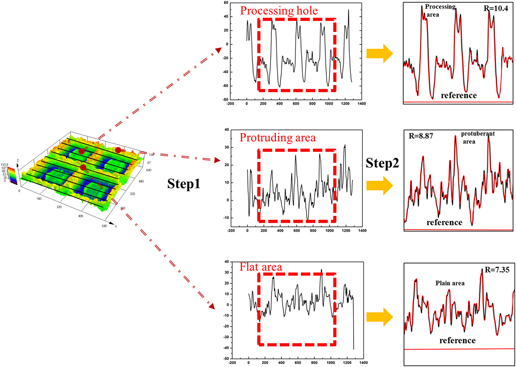Crossref Citations
This article has been cited by the following publications. This list is generated based on data provided by
Crossref.
Li, Qiaolei
Song, Peng
Yu, Xiao
He, Xuan
Khan, Asim
Cheng, Kunlun
Li, Chao
Lü, Kaiyue
and
Lu, Jiansheng
2018.
Heat-induced interface-coupling behaviour of thermally sprayed Cu/ceramic coatings.
Ceramics International,
Vol. 44,
Issue. 10,
p.
11918.
Yi, Peng
Jia, Delong
Zhan, Xianghua
Xu, Pengyun
and
Mostaghimi, Javad
2019.
Coating solidification mechanism during plasma-sprayed filling the laser textured grooves.
International Journal of Heat and Mass Transfer,
Vol. 142,
Issue. ,
p.
118451.
Li, Yuhang
Guan, Yingchun
Zhang, Zhen
and
Ynag, Shoufeng
2019.
Enhanced bond strength for micro-arc oxidation coating on magnesium alloy via laser surface microstructuring.
Applied Surface Science,
Vol. 478,
Issue. ,
p.
866.
Jia, Delong
Yi, Peng
Liu, Yancong
Sun, Jiawei
Zhao, Qi
Yue, Shengbo
Yang, Yue
Zhu, Jianqiang
Chen, Weibiao
Wang, Pu
Qiu, Jianrong
Zhang, Zhenxi
and
Zhong, Minlin
2020.
Effect of laser texture fitting grooves on plasma-sprayed filling coating model.
p.
55.
Jia, Delong
Liu, Yancong
Yi, Peng
Zhan, Xianghua
Ma, Jian
and
Mostaghimi, Javad
2020.
Splat formation mechanism of droplet-filled cold-textured groove during plasma spraying.
Applied Thermal Engineering,
Vol. 173,
Issue. ,
p.
115239.
Li, HongYan
Li, Qi
Liu, HongLi
Cao, Kai
Zhang, PengYu
Liu, Tong
Wang, DongMei
Liao, XiaoLan
and
Wei, DongQing
2020.
Fabrication of anti-icing surface with halloysite spherical microcapsule.
Journal of Materials Research,
Vol. 35,
Issue. 21,
p.
2887.
Liu, Huaile
Tong, Zhaopeng
Gu, Jiayang
Yang, Da
Yang, Haojie
and
Ren, xudong
2021.
Effect of Laser Surface Texturing Depth and Pattern on the Bond Strength and Corrosion Performance of Phosphate Conversion Coating on Magnesium Alloy.
SSRN Electronic Journal ,
Zhang, Zhao
Lu, Wenzhuang
Feng, Wei
Du, Xingzhu
and
Zuo, Dunwen
2021.
Effect of substrate surface texture on adhesion performance of diamond coating.
International Journal of Refractory Metals and Hard Materials,
Vol. 95,
Issue. ,
p.
105402.
Jia, Delong
Yi, Peng
Liu, Yancong
Jia, Hongyu
and
Yang, Xiaoshuang
2021.
Effect of the width and depth of laser-textured grooves on the bonding strength of plasma-sprayed coatings in the scratch direction.
Materials Science and Engineering: A,
Vol. 820,
Issue. ,
p.
141558.
Rossi, E. M.
Phani, P. Sudharshan
Guillemet, R.
Cholet, Julie
Jussey, Doriane
Oliver, W. C.
and
Sebastiani, M.
2021.
A novel nanoindentation protocol to characterize surface free energy of superhydrophobic nanopatterned materials.
Journal of Materials Research,
Vol. 36,
Issue. 11,
p.
2357.
Tan, Na
Li, Yang
Lou, Li-yan
Zhang, Guo-liang
Xing, Zhi-guo
and
Wang, Hai-dou
2021.
Influence of micro-nano multiscale surface texture on wettability of Ni-based droplets at high temperature.
Surface and Coatings Technology,
Vol. 418,
Issue. ,
p.
127103.
Liu, Huaile
Tong, Zhaopeng
Gu, Jiayang
yang, Da
Liu, Chang
Wang, Xiaoyang
and
Ren, Xudong
2022.
Effect of laser surface texturing depth and pattern on the bond strength and corrosion performance of phosphate conversion coating on magnesium alloy.
Optics & Laser Technology,
Vol. 153,
Issue. ,
p.
108164.
Ma, Guozheng
Chen, Shuying
and
Wang, Haidou
2022.
Micro Process and Quality Control of Plasma Spraying.
p.
291.
Chakraborty, Anustup
Chalfant, Benjamin
Sions, John
Zimmerman, Ben
and
Gupta, Mool C.
2023.
Improvement of thermal plasma sprayed coating adhesion strength by laser microtexturing of aluminum.
The International Journal of Advanced Manufacturing Technology,
Vol. 125,
Issue. 5-6,
p.
2629.
Zheng, Guoqiang
Lai, Fuqiang
Lin, Youxi
Yu, Jie
and
Ren, Zhiying
2023.
Study on the Friction-Reducing Mechanisms of Surface Texture Cemented Carbide under Dry Sliding.
Journal of Materials Engineering and Performance,
Vol. 32,
Issue. 5,
p.
2074.
Frutos, E.
Richhariya, V.
Silva, F.S.
and
Trindade, B.
2023.
Manufacture and mechanical-tribological assessment of diamond-reinforced Cu-based coatings for cutting/grinding tools.
Tribology International,
Vol. 177,
Issue. ,
p.
107947.
Mehmood, Kashif
Imran, Muhammad
Ali, Liaqat
Umer, Malik Adeel
Abbas, Musharaf
and
Saleem, Mohsin
2023.
Development of Cost-Effective Microstructure and Isothermal Oxidation-Resistant Bond Coats on Inconel 718 by Atmospheric Plasma-Sprayed NiCoCrAlFe High-Entropy Alloy.
JOM,
Vol. 75,
Issue. 1,
p.
239.
Zhang, Zhao
Qin, Xudong
Ma, Silu
Liu, Yang
Wang, Liping
and
Zhao, Xinyang
2023.
Synergistic Effect of WS2 and Micro-Textures to Inhibit Graphitization and Delamination of Micro-Nano Diamond-Coated Tools.
Crystals,
Vol. 13,
Issue. 7,
p.
1034.
Pan, Junchen
Chen, Xuejun
and
Lang, Fengchao
2024.
Tensile direction dependent failure of laser pretextured TiN coating/stainless steel substrate.
Materials Today Communications,
Vol. 40,
Issue. ,
p.
109487.
Bañón-García, Fermín
Bermudo Gamboa, Carolina
López-Fernández, José Andrés
Trujillo-Vilches, Francisco Javier
and
Martín-Béjar, Sergio
2024.
Correlation between Surface Texture, Wettability and Mechanical Strength of Polylactic Acid Parts Fabricated by Fused Filament Fabrication.
Coatings,
Vol. 14,
Issue. 8,
p.
1033.



